中考英语二轮语法专项复习课件 第十五讲 倒装句和构词法
文档属性
| 名称 | 中考英语二轮语法专项复习课件 第十五讲 倒装句和构词法 |
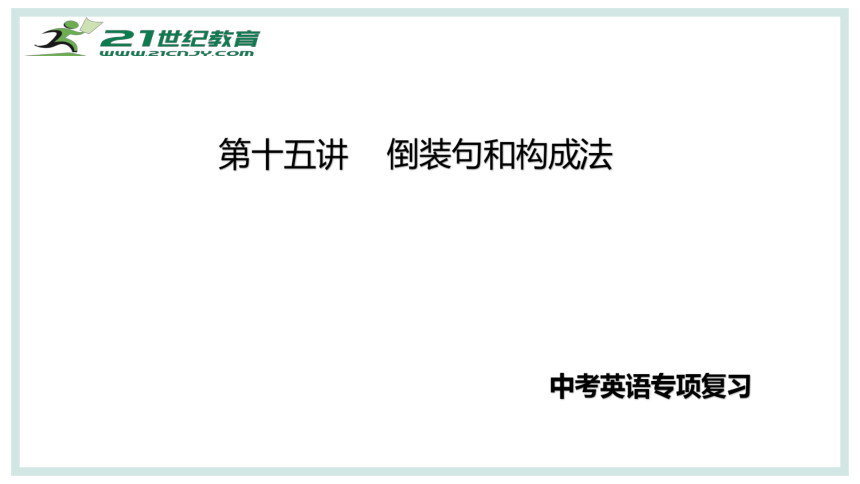
|
|
| 格式 | pptx | ||
| 文件大小 | 1.1MB | ||
| 资源类型 | 试卷 | ||
| 版本资源 | 鲁教版 | ||
| 科目 | 英语 | ||
| 更新时间 | 2024-01-03 21:50:32 | ||
图片预览

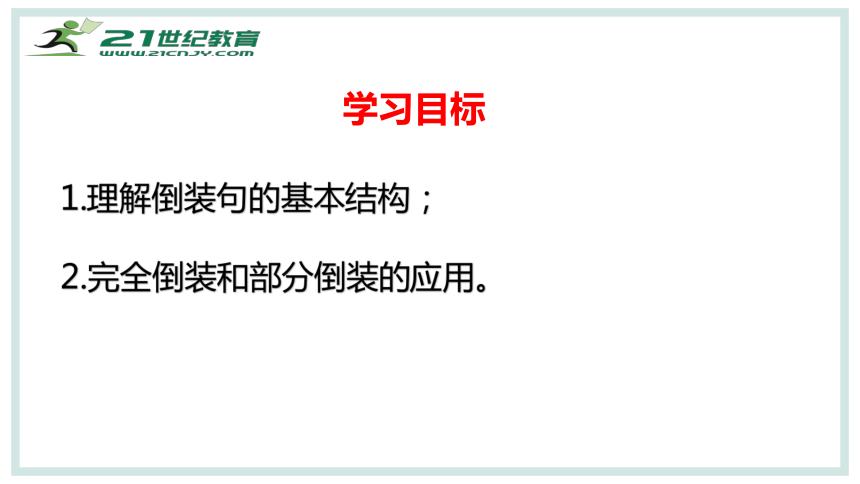

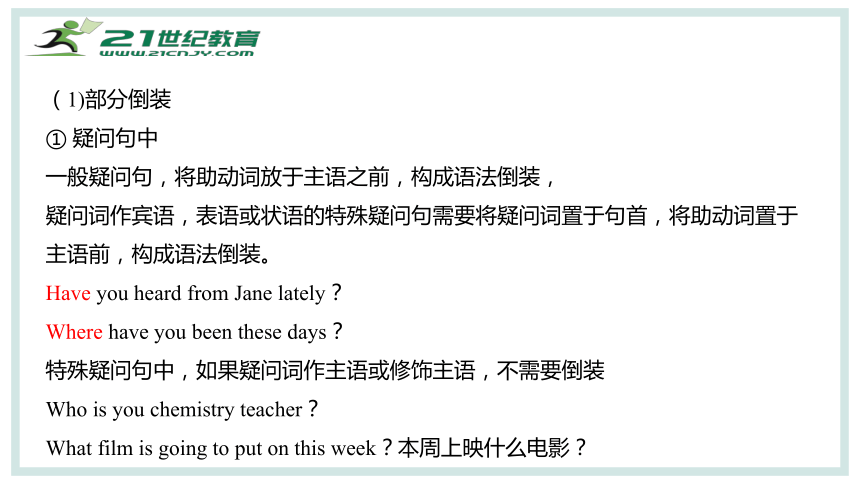
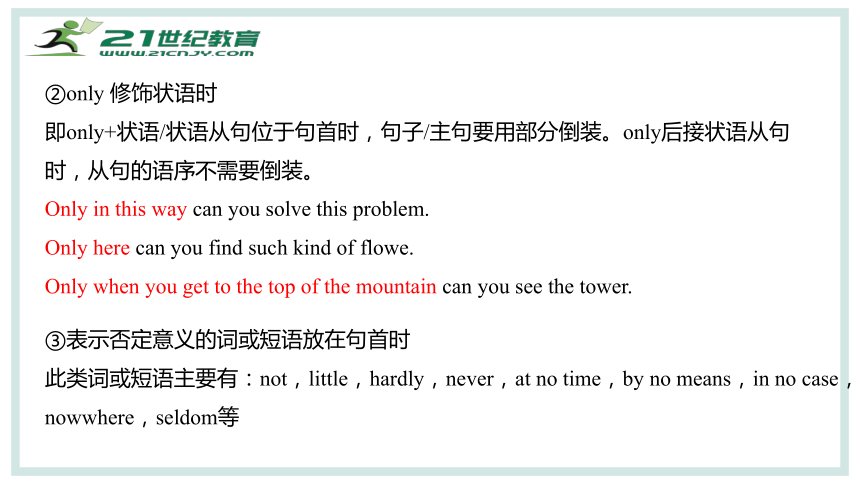
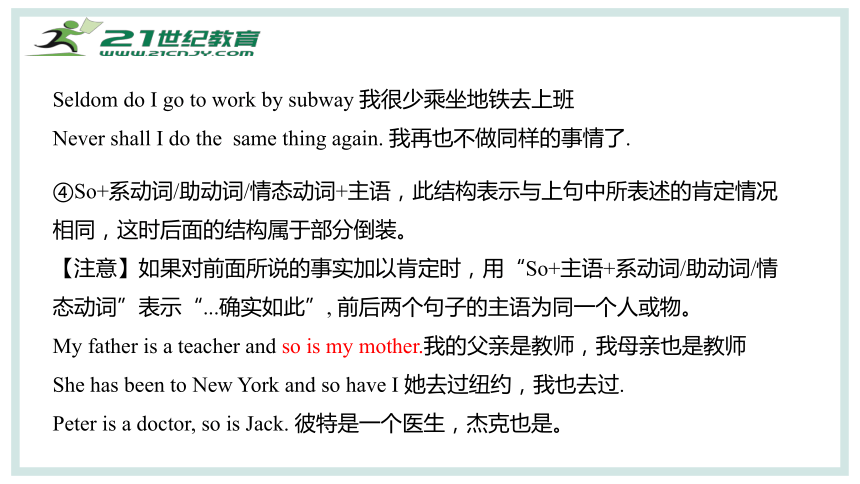
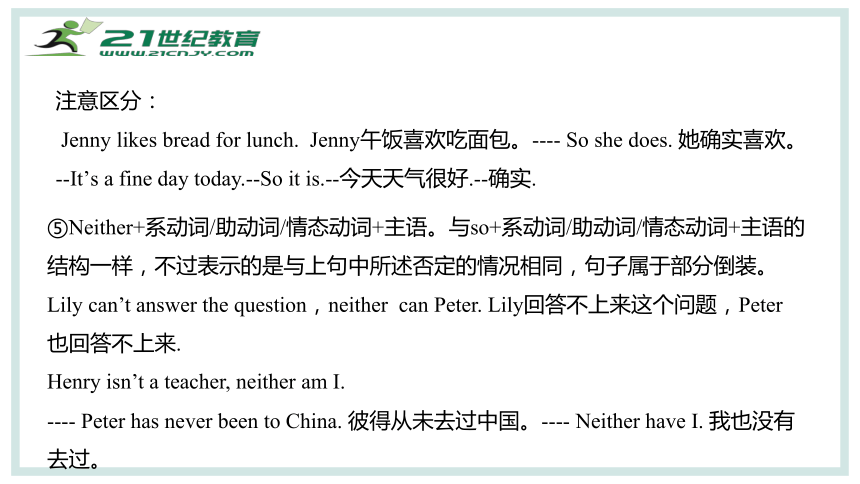
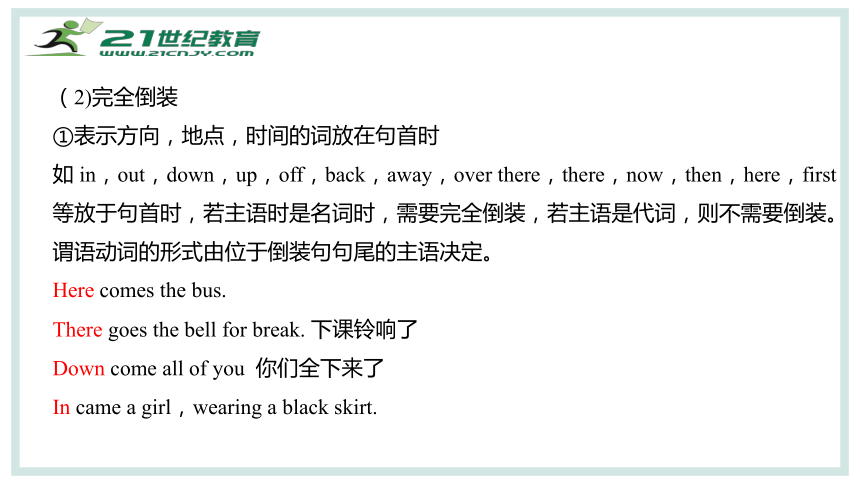
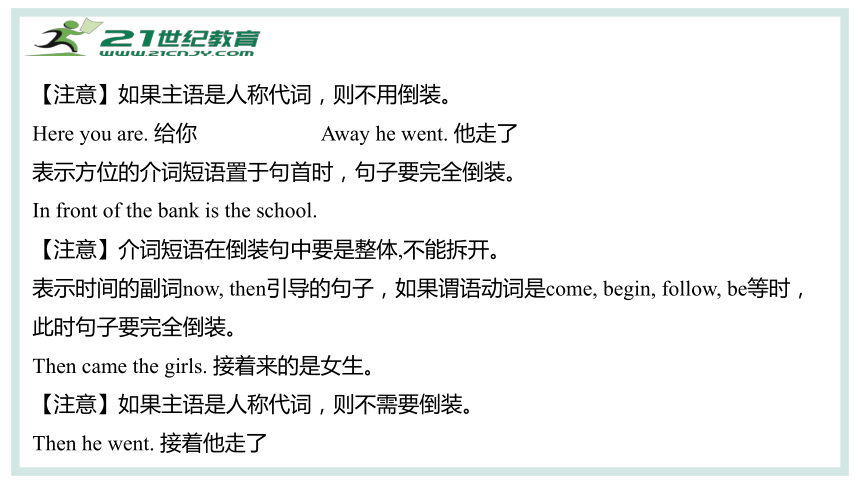
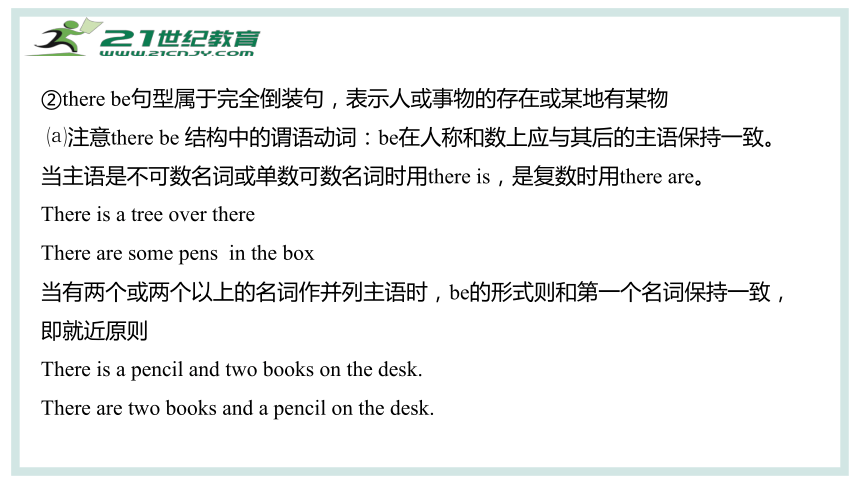
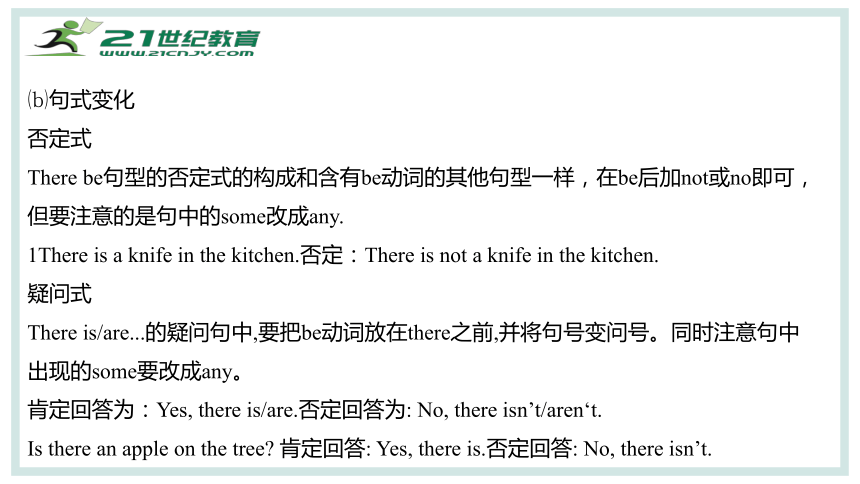
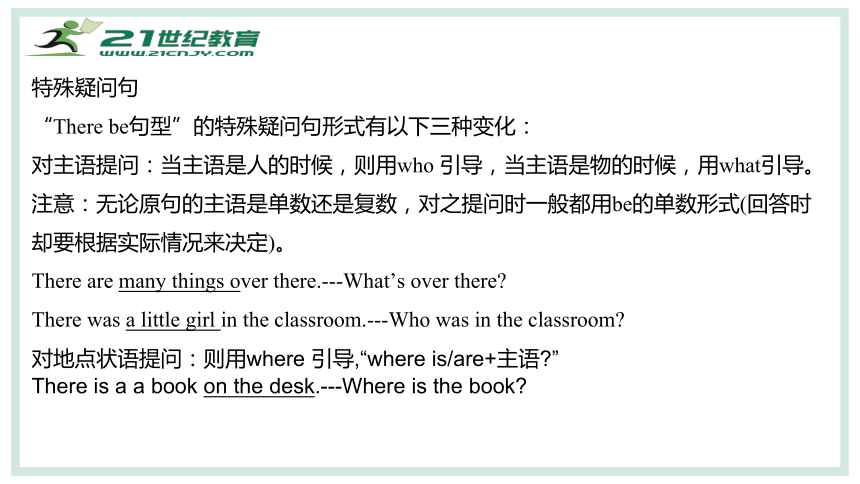
文档简介
(共39张PPT)
第十五讲 倒装句和构成法
中考英语专项复习
1.理解倒装句的基本结构;
2.完全倒装和部分倒装的应用。
学习目标
一 倒 装 句
英语句子的基本语序是主语+谓语+其它成分,即主语在前,谓语在后。但有时为了语法和修辞上的需要,将句子的整个谓语或着谓语的一部分放在主语的前面,便构成了倒装。
将主语和谓语完全颠倒过来,叫作完全倒装,
只将助动词,系动词,情态动词放在主语之前,叫作部分倒装,
(1)部分倒装
① 疑问句中
一般疑问句,将助动词放于主语之前,构成语法倒装,
疑问词作宾语,表语或状语的特殊疑问句需要将疑问词置于句首,将助动词置于主语前,构成语法倒装。
Have you heard from Jane lately?
Where have you been these days?
特殊疑问句中,如果疑问词作主语或修饰主语,不需要倒装
Who is you chemistry teacher?
What film is going to put on this week?本周上映什么电影?
②only 修饰状语时
即only+状语/状语从句位于句首时,句子/主句要用部分倒装。only后接状语从句时,从句的语序不需要倒装。
Only in this way can you solve this problem.
Only here can you find such kind of flowe.
Only when you get to the top of the mountain can you see the tower.
③表示否定意义的词或短语放在句首时
此类词或短语主要有:not,little,hardly,never,at no time,by no means,in no case,nowwhere,seldom等
Seldom do I go to work by subway 我很少乘坐地铁去上班
Never shall I do the same thing again. 我再也不做同样的事情了.
④So+系动词/助动词/情态动词+主语,此结构表示与上句中所表述的肯定情况相同,这时后面的结构属于部分倒装。
【注意】如果对前面所说的事实加以肯定时,用“So+主语+系动词/助动词/情态动词”表示“...确实如此”, 前后两个句子的主语为同一个人或物。
My father is a teacher and so is my mother.我的父亲是教师,我母亲也是教师
She has been to New York and so have I 她去过纽约,我也去过.
Peter is a doctor, so is Jack. 彼特是一个医生,杰克也是。
注意区分:
Jenny likes bread for lunch. Jenny午饭喜欢吃面包。---- So she does. 她确实喜欢。
--It’s a fine day today.--So it is.--今天天气很好.--确实.
⑤Neither+系动词/助动词/情态动词+主语。与so+系动词/助动词/情态动词+主语的结构一样,不过表示的是与上句中所述否定的情况相同,句子属于部分倒装。
Lily can’t answer the question,neither can Peter. Lily回答不上来这个问题,Peter 也回答不上来.
Henry isn’t a teacher, neither am I.
---- Peter has never been to China. 彼得从未去过中国。---- Neither have I. 我也没有去过。
(2)完全倒装
①表示方向,地点,时间的词放在句首时
如 in,out,down,up,off,back,away,over there,there,now,then,here,first等放于句首时,若主语时是名词时,需要完全倒装,若主语是代词,则不需要倒装。谓语动词的形式由位于倒装句句尾的主语决定。
Here comes the bus.
There goes the bell for break. 下课铃响了
Down come all of you 你们全下来了
In came a girl,wearing a black skirt.
【注意】如果主语是人称代词,则不用倒装。
Here you are. 给你 Away he went. 他走了
表示方位的介词短语置于句首时,句子要完全倒装。
In front of the bank is the school.
【注意】介词短语在倒装句中要是整体,不能拆开。
表示时间的副词now, then引导的句子,如果谓语动词是come, begin, follow, be等时,此时句子要完全倒装。
Then came the girls. 接着来的是女生。
【注意】如果主语是人称代词,则不需要倒装。
Then he went. 接着他走了
②there be句型属于完全倒装句,表示人或事物的存在或某地有某物
注意there be 结构中的谓语动词:be在人称和数上应与其后的主语保持一致。
当主语是不可数名词或单数可数名词时用there is,是复数时用there are。
There is a tree over there
There are some pens in the box
当有两个或两个以上的名词作并列主语时,be的形式则和第一个名词保持一致,即就近原则
There is a pencil and two books on the desk.
There are two books and a pencil on the desk.
文本信息
句式变化
否定式
There be句型的否定式的构成和含有be动词的其他句型一样,在be后加not或no即可,但要注意的是句中的some改成any.
1There is a knife in the kitchen.否定:There is not a knife in the kitchen.
疑问式
There is/are...的疑问句中,要把be动词放在there之前,并将句号变问号。同时注意句中出现的some要改成any。
肯定回答为:Yes, there is/are.否定回答为: No, there isn’t/aren‘t.
Is there an apple on the tree 肯定回答: Yes, there is.否定回答: No, there isn’t.
文本信息
特殊疑问句
“There be句型”的特殊疑问句形式有以下三种变化:
对主语提问:当主语是人的时候,则用who 引导,当主语是物的时候,用what引导。
注意:无论原句的主语是单数还是复数,对之提问时一般都用be的单数形式(回答时却要根据实际情况来决定)。
There are many things over there.---What’s over there
There was a little girl in the classroom.---Who was in the classroom
对地点状语提问:则用where 引导,“where is/are+主语 ”
There is a a book on the desk.---Where is the book
对数量提问:一般有两种句型结构:
How many+复数名词+are/were (there)+介词短语?
There’re many children in the park.
How many children are(there)in the park
How much+不可数名词+is/was there+介词短语?
There was little rain around the year.
How much rain was (there)around the year
文本信息
there be 句型的时态变化
初中阶段t常见的here be 句型中动词be的时态变化
一般现在时即there is /there are
一般过去时there was/there were
一般将来时there will be/there is going to be/there are going to be
There is going to be an English film tonight.
There are going to be two foot matches this afternoon
现在完成时there have been/there has been
There have been strange happenings here lately.
还可用情态动词连用,如there must be ,there can’t be, there used to be
There be结构中的be根据所表达的句意需要,有时会被替换为其他行为动词(come , live ,stand , lie, seem to be , happen to be 等)。
Once upon a time, there lived a princess who was very beautiful.
从前,有一位非常美丽的公主。
There seems to be a knife and a fork on the table.
There be 句型的反意疑问句:反意疑问句的附加部分应用there。
There is some milk in the cup, isn’t there 杯子里有牛奶,是吗?
There are no letters in the box, are there 盒子里没有信件,是吗?
There will be a new school nearby, won’t there 附近要建一家新学校,是吗?
二 构 词 法
英语中常见的构词法有:合成法 派生法 转化法 缩略法
输入标题文本信息
标题数字等都可以通过点击和重新输入进行更改。文字数字大小颜色参考此模板
(1)合成法
合成词 例 词
合 成 名 词 n.+ n, snowman spaceship newspaper
n.+ v. daybreak sunrise
n.+ v.ing handwriting 笔迹,字迹 decision-making 决策
v.ing+n. dining room washing machine swimming pool
v.+n. postcard playround
adj.+n. gentleman green hand 新手
其它形式 get-together 聚会 take-off 起飞 pain-killer 止痛药
合 成 词 例 词
合 成 形 容 词 adj.+n.+-ed kind-hearted midde-aged white-colored
adj.+v.ing good-looking easy-going
adj.+n. part-time full-time
n.+v.ed man-made water-covered
n.+v.ing peace-loving English-speaking
其它形式 ice-cool new-born one-eyed two-year-old well-known
合成词 例词
合成动词 overthrow 推翻 underline 在下面画线 whitewash 粉刷
合成副词 anywhere however nowdays maybe outdoors 户外 upstairs 楼上 otherwise 否则
合成代词 himself everyone nothing anther
(2)派生法
在词根的前面加前缀或在词根的后面加后缀构成一个与原单词意义相近或相反的新的词,这种构词方法叫做派生法。
加在单词前面的词缀叫前缀,加在单词后面的词缀叫后缀。
①否定意义的前缀,在某些单词的前面加这类前缀常构成与该单词意义相反的新词。
前 缀 例 词
dis-否定, 主要放在n.v.adj前 dislike disagree disappear disadvantage disabled
im -不, 常放于字母m, b, p前 impossible impolite 无礼的 imperfect 有缺点的
in -不, 常放于adj. n.前 incorrect 不正确的 indirect 间接的 informal非正式的
un-不,常放于n.adj.adv.前 unhappy unexpectedly unluck unfair unable unhealthy
mis-不,常放于v. n.前 misuse 错用 misunderstand误解 mistke 错误
non-不 常放于adj,n.前 non-drinker non-smoker non-profit 非盈利的
前 缀 例 词
ir-不, 放在以r开头的单词前 irregular无规律的 irresponsible
de- 加在n、adj.前 decolor 脱色
anti- 加在n、adj.前 antihuman反人类的 antiwar 反战的
counter- 加在n、v前 counteraction反作用 counterpart对应的人或物
il- 主要加在以l开头的单词的前 ilegal 非法的;illiterate 文盲的
点击此处
输入文本信息
②表示其它意义的前缀
前 缀 例 词
a- 多构成表语形容词 alone asleep awake
auto-表示 自动 automatic 自动的 autonomous自治的
bi-表示二 biweekly 两周一次 bicycle
co-表示共同,和 cooperate 合 作 co-worker同事
down- 表示往下 download 下载 downstairs楼下
en- 表示使…… enjoy使高兴 endanger(使)遇危险
enlarge变大 enable(使)能够
前 缀 例 词
fore- 表示前的 forehaed 前 额 foresee远见 预见 forearm 前臂
inter- 表示互相,在……之间 interchangeble 可互换的international 国际的
internet互联网
kilo- 表示千 kilometer kilogram千克,公斤
mid- 表示中间的 midnight 午夜;mid-autumn中秋
multi-表示多 multi-colored 颜色多样的 multi-national(多国的)
post-表示后 post-war 战 后
点击此处
输入文本信息
前 缀 例 词
re- 表示重新,再,又 reuse 再利用 retell 复述 rewrite 重写 rebuild 重建
sub- 表示下面的,次 subway 地铁 subtitle 副标题
super- 表示超级的” superman 超人;supermarket 超市
trans- 表示通过,横过 translation 翻译 transport 运输
tele- 表示远的 telephone 电话 television 电视
uni-单一,一致 uniform unit单元 unicycle 独轮车
(2)后缀。后缀通会改变单词的词性,构成意义相近的其他词性;或者部分后缀会改变词义,变为与原来词义相反的新词。
后 缀 例 词
名 词 后 缀 -(a)n表示某国人 Australian澳大利亚人Italian意大利人Canadian加拿大人
-ance, -ence表示性质,程度 acceptance接受 dependence依靠 importance,importance
-ce表示性质,程度 difference 不同点 patience耐心
-ese表示某国人 Chinese Japanese
-ess表示雌性 actress女演员lioness 母狮子
-er表示从事某事的人 singer driver writer runner winner travller
后 缀 例 词 名 词 后 缀 -hood表示关系或抽象意义 motherhood母亲身份;childhoodneighborhood
-ian表示精通……的人 musician音乐家
-ing表示“动作的过程,结果” feeling感觉,感情,reading 阅读,读物
-ion,-sion,-tion,-ation,-ition,表示行为的过程,结果,状况” action expression 表达 pronunciation 发音
invitation 邀请 decision 决定discussion讨论 invention 发明 pollution污染 celebration 庆祝
-ist表示“专业人员” pianist scientist artist violinist
-ment表示“性质;状态” agreement 同意,协议 development punishment 惩罚
-ness表示“性质;状态” happiness 幸福business 事务;illness疾病;sadness悲痛;kindness和蔼 weakness弱点,虚弱
后缀 例词 名 词 后 缀 -or表示“从事某事的人” actor visitor inventor发明家/人创造者
-ship 表示状态、抽象概念 friendship友谊 relationship关系
-th warmth温暖;truth 真理;length 长度;
youth青年;death死亡;growth成长
-ty 表示特性或情况 difficulty safety 安全 beauty美人;ability能力
-ture picture culture 文化,文明 temperature 温度
-(s)ure表示“行为,结果” failure 失败;故障;pleasure快乐,令人高兴的事
后缀 例 词 动 词 后 缀 -en 使得,变得,多用于adj.n后变成动词 widen加宽 deepen 加深
-fy表示使……化 beautify美化,sastisfy 满意 simplify 简化
-ize/-ise表示使……成为 realize意识到;organize组织 apologize 道歉
criticise 批评
后缀 例 词 形 容 词 后 缀 -able/-ible表示“有能力的” reasonable有道理的 enjoyable 令人愉快的 comfortable acceptable responsible 负责任的
-al/-ial natural 自然的 national 民族的国家的 speicial
-an/ian表示某国(人)的 American美国(人)的;Australian澳大利亚(人)的;Indian印度(人)的 African 非洲(人)的
-ed moved受感动的 interested bored
-en 多用于表示材料的名词后“由……构成的” woolen羊毛的 golden金的;wooden木制的
后缀 例 词 形 容 词 后 缀 -ent/-ant pleasant dependent different
-ern表示方向 eastern东方的southern南方的northern北方的western西方的
-ese表示某国人的 Chinese中国人的Japanese日本人的
-ful beautiful hopeful wonderful careful小心的colorful多彩的
-ing moving 感动的;encouraging 鼓舞人心的;exciting令人激动的;interesting有趣的
-(ic)al electrical 电的;historical历史的;economical经济的;political政治的 chemical 化学的
-ish childish孩子气的 selfish自私的
后缀 例 词 形 容 词 后 缀 -ive active积极的 expensive贵的 progressive 有进展的
-less 表示“否定” careless 粗心的 useless 无用的 hopeless 没有希望的;helpless无助的 harmless 无害的 homeless 无家的
-like表示像...一样的 boylike像男孩一样的;motherlike像母亲一样的
-ly friendly友好的 yearly每年的lovely可爱的;lively活泼的
-ous famous nerivous 紧张的 delicious humorous serious
-some handsome英俊的 tiresome疲惫的;lonesome孤独的
-(t)y thirsty口渴的 noisy吵闹的 healthy健康的
-y 多用于天气类 snowy下雪的 rainy下雨的 cloudy多云的 windy 有风的
后缀 例 词 副 词 后 缀 -ly主要用于形容词,把此形容词变为副词 quietly 安静地 angrily生气地 slowly慢慢地
sadly 悲伤地 silently 沉默地
-ward(s) 主要用于表示方位的词之后表示方向 towards 朝……,向……eastward向东方地
backwards向后退地 upwards向上地;
westward向西地 northward向北
-wise otherwise否则 likewise同样地;
clockwise顺时针方向地;
后缀 例 词 数 词 后 缀 -teen (十几) thirteen13 fourteen14 fifteen15 sixteen16
seventeen 17 eighteen18 nineteen 19
-ty (几十) twenty20 thirty30 forty40 fifty50 sixty60
seventy 70 eighty 80 ninety 90
-th (构成序数词) fourth 第四 fifth第五 sixth第六 hundredth 第一百
(3)转化法
即有的名词可直接作动词,有的形容词可作直接作副词或动词等,这种直接把一种词性用作另一种词性而词形不变的方法叫做转化法。
转 化 方 法 例 词
名词 动词 hand 手 递 watch 手表 观看 smoke 烟 吸烟
名词 形容词 light 光线 明亮的 right 右边 对的
动词 形容词 clean 打扫 干净的 close 关闭 进的 free 使自由 自由的
副词 形容词 enough 足够的 足够地 last 最后 最后的
读音不同 词性不同 下列单词动词时重音在后,名词时重音在前:
increase 增长 progress 进步 record 记录 refuse 拒绝
(4) 缩略法
构成方式 例 词 剪切法 剪切原词的开始部分 airplane plane telephone phone
剪切原词的末尾部分 examination exam laboratory→lab
混成法 将两个单词各取一部分构成一个新词 smoke+fog smog 烟雾
motor+hotel motel 汽车旅馆
首字母缩略法 按首字母拼读的缩略语 Do It Yourself DIY
World Trade Organization WTO
像字母一样拼读的首字母缩写 North Atlantic Treaty Organization
NATO ['ne t ]北大西洋公约组织
三 实 战 演 练
1.If you don’t go to the mountains tomorrow, ________.
A.so will I B.neither will I C.neither do I
2.—My mother always takes a cloth bag when she goes shopping.
—________. I think it is more environmentally friendly.
A.So do I B.So I do C.Neither do I D.Neither I do
B
A
3-Did you enjoy that trip
--I'm afraid not, and _____
A. so didn't my classmates B. my classmates don't too
C. neither do my classmates D. neither did my classmates
D
4.—The boy’s made so many mistakes in this paper.
—It’s OK. ________. This paper is very difficult.
A.So have other students
B.So do other students
C.Neither has other students
C
谢谢
21世纪教育网(www.21cnjy.com)
中小学教育资源网站
兼职招聘:
https://www.21cnjy.com/recruitment/home/admin
第十五讲 倒装句和构成法
中考英语专项复习
1.理解倒装句的基本结构;
2.完全倒装和部分倒装的应用。
学习目标
一 倒 装 句
英语句子的基本语序是主语+谓语+其它成分,即主语在前,谓语在后。但有时为了语法和修辞上的需要,将句子的整个谓语或着谓语的一部分放在主语的前面,便构成了倒装。
将主语和谓语完全颠倒过来,叫作完全倒装,
只将助动词,系动词,情态动词放在主语之前,叫作部分倒装,
(1)部分倒装
① 疑问句中
一般疑问句,将助动词放于主语之前,构成语法倒装,
疑问词作宾语,表语或状语的特殊疑问句需要将疑问词置于句首,将助动词置于主语前,构成语法倒装。
Have you heard from Jane lately?
Where have you been these days?
特殊疑问句中,如果疑问词作主语或修饰主语,不需要倒装
Who is you chemistry teacher?
What film is going to put on this week?本周上映什么电影?
②only 修饰状语时
即only+状语/状语从句位于句首时,句子/主句要用部分倒装。only后接状语从句时,从句的语序不需要倒装。
Only in this way can you solve this problem.
Only here can you find such kind of flowe.
Only when you get to the top of the mountain can you see the tower.
③表示否定意义的词或短语放在句首时
此类词或短语主要有:not,little,hardly,never,at no time,by no means,in no case,nowwhere,seldom等
Seldom do I go to work by subway 我很少乘坐地铁去上班
Never shall I do the same thing again. 我再也不做同样的事情了.
④So+系动词/助动词/情态动词+主语,此结构表示与上句中所表述的肯定情况相同,这时后面的结构属于部分倒装。
【注意】如果对前面所说的事实加以肯定时,用“So+主语+系动词/助动词/情态动词”表示“...确实如此”, 前后两个句子的主语为同一个人或物。
My father is a teacher and so is my mother.我的父亲是教师,我母亲也是教师
She has been to New York and so have I 她去过纽约,我也去过.
Peter is a doctor, so is Jack. 彼特是一个医生,杰克也是。
注意区分:
Jenny likes bread for lunch. Jenny午饭喜欢吃面包。---- So she does. 她确实喜欢。
--It’s a fine day today.--So it is.--今天天气很好.--确实.
⑤Neither+系动词/助动词/情态动词+主语。与so+系动词/助动词/情态动词+主语的结构一样,不过表示的是与上句中所述否定的情况相同,句子属于部分倒装。
Lily can’t answer the question,neither can Peter. Lily回答不上来这个问题,Peter 也回答不上来.
Henry isn’t a teacher, neither am I.
---- Peter has never been to China. 彼得从未去过中国。---- Neither have I. 我也没有去过。
(2)完全倒装
①表示方向,地点,时间的词放在句首时
如 in,out,down,up,off,back,away,over there,there,now,then,here,first等放于句首时,若主语时是名词时,需要完全倒装,若主语是代词,则不需要倒装。谓语动词的形式由位于倒装句句尾的主语决定。
Here comes the bus.
There goes the bell for break. 下课铃响了
Down come all of you 你们全下来了
In came a girl,wearing a black skirt.
【注意】如果主语是人称代词,则不用倒装。
Here you are. 给你 Away he went. 他走了
表示方位的介词短语置于句首时,句子要完全倒装。
In front of the bank is the school.
【注意】介词短语在倒装句中要是整体,不能拆开。
表示时间的副词now, then引导的句子,如果谓语动词是come, begin, follow, be等时,此时句子要完全倒装。
Then came the girls. 接着来的是女生。
【注意】如果主语是人称代词,则不需要倒装。
Then he went. 接着他走了
②there be句型属于完全倒装句,表示人或事物的存在或某地有某物
注意there be 结构中的谓语动词:be在人称和数上应与其后的主语保持一致。
当主语是不可数名词或单数可数名词时用there is,是复数时用there are。
There is a tree over there
There are some pens in the box
当有两个或两个以上的名词作并列主语时,be的形式则和第一个名词保持一致,即就近原则
There is a pencil and two books on the desk.
There are two books and a pencil on the desk.
文本信息
句式变化
否定式
There be句型的否定式的构成和含有be动词的其他句型一样,在be后加not或no即可,但要注意的是句中的some改成any.
1There is a knife in the kitchen.否定:There is not a knife in the kitchen.
疑问式
There is/are...的疑问句中,要把be动词放在there之前,并将句号变问号。同时注意句中出现的some要改成any。
肯定回答为:Yes, there is/are.否定回答为: No, there isn’t/aren‘t.
Is there an apple on the tree 肯定回答: Yes, there is.否定回答: No, there isn’t.
文本信息
特殊疑问句
“There be句型”的特殊疑问句形式有以下三种变化:
对主语提问:当主语是人的时候,则用who 引导,当主语是物的时候,用what引导。
注意:无论原句的主语是单数还是复数,对之提问时一般都用be的单数形式(回答时却要根据实际情况来决定)。
There are many things over there.---What’s over there
There was a little girl in the classroom.---Who was in the classroom
对地点状语提问:则用where 引导,“where is/are+主语 ”
There is a a book on the desk.---Where is the book
对数量提问:一般有两种句型结构:
How many+复数名词+are/were (there)+介词短语?
There’re many children in the park.
How many children are(there)in the park
How much+不可数名词+is/was there+介词短语?
There was little rain around the year.
How much rain was (there)around the year
文本信息
there be 句型的时态变化
初中阶段t常见的here be 句型中动词be的时态变化
一般现在时即there is /there are
一般过去时there was/there were
一般将来时there will be/there is going to be/there are going to be
There is going to be an English film tonight.
There are going to be two foot matches this afternoon
现在完成时there have been/there has been
There have been strange happenings here lately.
还可用情态动词连用,如there must be ,there can’t be, there used to be
There be结构中的be根据所表达的句意需要,有时会被替换为其他行为动词(come , live ,stand , lie, seem to be , happen to be 等)。
Once upon a time, there lived a princess who was very beautiful.
从前,有一位非常美丽的公主。
There seems to be a knife and a fork on the table.
There be 句型的反意疑问句:反意疑问句的附加部分应用there。
There is some milk in the cup, isn’t there 杯子里有牛奶,是吗?
There are no letters in the box, are there 盒子里没有信件,是吗?
There will be a new school nearby, won’t there 附近要建一家新学校,是吗?
二 构 词 法
英语中常见的构词法有:合成法 派生法 转化法 缩略法
输入标题文本信息
标题数字等都可以通过点击和重新输入进行更改。文字数字大小颜色参考此模板
(1)合成法
合成词 例 词
合 成 名 词 n.+ n, snowman spaceship newspaper
n.+ v. daybreak sunrise
n.+ v.ing handwriting 笔迹,字迹 decision-making 决策
v.ing+n. dining room washing machine swimming pool
v.+n. postcard playround
adj.+n. gentleman green hand 新手
其它形式 get-together 聚会 take-off 起飞 pain-killer 止痛药
合 成 词 例 词
合 成 形 容 词 adj.+n.+-ed kind-hearted midde-aged white-colored
adj.+v.ing good-looking easy-going
adj.+n. part-time full-time
n.+v.ed man-made water-covered
n.+v.ing peace-loving English-speaking
其它形式 ice-cool new-born one-eyed two-year-old well-known
合成词 例词
合成动词 overthrow 推翻 underline 在下面画线 whitewash 粉刷
合成副词 anywhere however nowdays maybe outdoors 户外 upstairs 楼上 otherwise 否则
合成代词 himself everyone nothing anther
(2)派生法
在词根的前面加前缀或在词根的后面加后缀构成一个与原单词意义相近或相反的新的词,这种构词方法叫做派生法。
加在单词前面的词缀叫前缀,加在单词后面的词缀叫后缀。
①否定意义的前缀,在某些单词的前面加这类前缀常构成与该单词意义相反的新词。
前 缀 例 词
dis-否定, 主要放在n.v.adj前 dislike disagree disappear disadvantage disabled
im -不, 常放于字母m, b, p前 impossible impolite 无礼的 imperfect 有缺点的
in -不, 常放于adj. n.前 incorrect 不正确的 indirect 间接的 informal非正式的
un-不,常放于n.adj.adv.前 unhappy unexpectedly unluck unfair unable unhealthy
mis-不,常放于v. n.前 misuse 错用 misunderstand误解 mistke 错误
non-不 常放于adj,n.前 non-drinker non-smoker non-profit 非盈利的
前 缀 例 词
ir-不, 放在以r开头的单词前 irregular无规律的 irresponsible
de- 加在n、adj.前 decolor 脱色
anti- 加在n、adj.前 antihuman反人类的 antiwar 反战的
counter- 加在n、v前 counteraction反作用 counterpart对应的人或物
il- 主要加在以l开头的单词的前 ilegal 非法的;illiterate 文盲的
点击此处
输入文本信息
②表示其它意义的前缀
前 缀 例 词
a- 多构成表语形容词 alone asleep awake
auto-表示 自动 automatic 自动的 autonomous自治的
bi-表示二 biweekly 两周一次 bicycle
co-表示共同,和 cooperate 合 作 co-worker同事
down- 表示往下 download 下载 downstairs楼下
en- 表示使…… enjoy使高兴 endanger(使)遇危险
enlarge变大 enable(使)能够
前 缀 例 词
fore- 表示前的 forehaed 前 额 foresee远见 预见 forearm 前臂
inter- 表示互相,在……之间 interchangeble 可互换的international 国际的
internet互联网
kilo- 表示千 kilometer kilogram千克,公斤
mid- 表示中间的 midnight 午夜;mid-autumn中秋
multi-表示多 multi-colored 颜色多样的 multi-national(多国的)
post-表示后 post-war 战 后
点击此处
输入文本信息
前 缀 例 词
re- 表示重新,再,又 reuse 再利用 retell 复述 rewrite 重写 rebuild 重建
sub- 表示下面的,次 subway 地铁 subtitle 副标题
super- 表示超级的” superman 超人;supermarket 超市
trans- 表示通过,横过 translation 翻译 transport 运输
tele- 表示远的 telephone 电话 television 电视
uni-单一,一致 uniform unit单元 unicycle 独轮车
(2)后缀。后缀通会改变单词的词性,构成意义相近的其他词性;或者部分后缀会改变词义,变为与原来词义相反的新词。
后 缀 例 词
名 词 后 缀 -(a)n表示某国人 Australian澳大利亚人Italian意大利人Canadian加拿大人
-ance, -ence表示性质,程度 acceptance接受 dependence依靠 importance,importance
-ce表示性质,程度 difference 不同点 patience耐心
-ese表示某国人 Chinese Japanese
-ess表示雌性 actress女演员lioness 母狮子
-er表示从事某事的人 singer driver writer runner winner travller
后 缀 例 词 名 词 后 缀 -hood表示关系或抽象意义 motherhood母亲身份;childhoodneighborhood
-ian表示精通……的人 musician音乐家
-ing表示“动作的过程,结果” feeling感觉,感情,reading 阅读,读物
-ion,-sion,-tion,-ation,-ition,表示行为的过程,结果,状况” action expression 表达 pronunciation 发音
invitation 邀请 decision 决定discussion讨论 invention 发明 pollution污染 celebration 庆祝
-ist表示“专业人员” pianist scientist artist violinist
-ment表示“性质;状态” agreement 同意,协议 development punishment 惩罚
-ness表示“性质;状态” happiness 幸福business 事务;illness疾病;sadness悲痛;kindness和蔼 weakness弱点,虚弱
后缀 例词 名 词 后 缀 -or表示“从事某事的人” actor visitor inventor发明家/人创造者
-ship 表示状态、抽象概念 friendship友谊 relationship关系
-th warmth温暖;truth 真理;length 长度;
youth青年;death死亡;growth成长
-ty 表示特性或情况 difficulty safety 安全 beauty美人;ability能力
-ture picture culture 文化,文明 temperature 温度
-(s)ure表示“行为,结果” failure 失败;故障;pleasure快乐,令人高兴的事
后缀 例 词 动 词 后 缀 -en 使得,变得,多用于adj.n后变成动词 widen加宽 deepen 加深
-fy表示使……化 beautify美化,sastisfy 满意 simplify 简化
-ize/-ise表示使……成为 realize意识到;organize组织 apologize 道歉
criticise 批评
后缀 例 词 形 容 词 后 缀 -able/-ible表示“有能力的” reasonable有道理的 enjoyable 令人愉快的 comfortable acceptable responsible 负责任的
-al/-ial natural 自然的 national 民族的国家的 speicial
-an/ian表示某国(人)的 American美国(人)的;Australian澳大利亚(人)的;Indian印度(人)的 African 非洲(人)的
-ed moved受感动的 interested bored
-en 多用于表示材料的名词后“由……构成的” woolen羊毛的 golden金的;wooden木制的
后缀 例 词 形 容 词 后 缀 -ent/-ant pleasant dependent different
-ern表示方向 eastern东方的southern南方的northern北方的western西方的
-ese表示某国人的 Chinese中国人的Japanese日本人的
-ful beautiful hopeful wonderful careful小心的colorful多彩的
-ing moving 感动的;encouraging 鼓舞人心的;exciting令人激动的;interesting有趣的
-(ic)al electrical 电的;historical历史的;economical经济的;political政治的 chemical 化学的
-ish childish孩子气的 selfish自私的
后缀 例 词 形 容 词 后 缀 -ive active积极的 expensive贵的 progressive 有进展的
-less 表示“否定” careless 粗心的 useless 无用的 hopeless 没有希望的;helpless无助的 harmless 无害的 homeless 无家的
-like表示像...一样的 boylike像男孩一样的;motherlike像母亲一样的
-ly friendly友好的 yearly每年的lovely可爱的;lively活泼的
-ous famous nerivous 紧张的 delicious humorous serious
-some handsome英俊的 tiresome疲惫的;lonesome孤独的
-(t)y thirsty口渴的 noisy吵闹的 healthy健康的
-y 多用于天气类 snowy下雪的 rainy下雨的 cloudy多云的 windy 有风的
后缀 例 词 副 词 后 缀 -ly主要用于形容词,把此形容词变为副词 quietly 安静地 angrily生气地 slowly慢慢地
sadly 悲伤地 silently 沉默地
-ward(s) 主要用于表示方位的词之后表示方向 towards 朝……,向……eastward向东方地
backwards向后退地 upwards向上地;
westward向西地 northward向北
-wise otherwise否则 likewise同样地;
clockwise顺时针方向地;
后缀 例 词 数 词 后 缀 -teen (十几) thirteen13 fourteen14 fifteen15 sixteen16
seventeen 17 eighteen18 nineteen 19
-ty (几十) twenty20 thirty30 forty40 fifty50 sixty60
seventy 70 eighty 80 ninety 90
-th (构成序数词) fourth 第四 fifth第五 sixth第六 hundredth 第一百
(3)转化法
即有的名词可直接作动词,有的形容词可作直接作副词或动词等,这种直接把一种词性用作另一种词性而词形不变的方法叫做转化法。
转 化 方 法 例 词
名词 动词 hand 手 递 watch 手表 观看 smoke 烟 吸烟
名词 形容词 light 光线 明亮的 right 右边 对的
动词 形容词 clean 打扫 干净的 close 关闭 进的 free 使自由 自由的
副词 形容词 enough 足够的 足够地 last 最后 最后的
读音不同 词性不同 下列单词动词时重音在后,名词时重音在前:
increase 增长 progress 进步 record 记录 refuse 拒绝
(4) 缩略法
构成方式 例 词 剪切法 剪切原词的开始部分 airplane plane telephone phone
剪切原词的末尾部分 examination exam laboratory→lab
混成法 将两个单词各取一部分构成一个新词 smoke+fog smog 烟雾
motor+hotel motel 汽车旅馆
首字母缩略法 按首字母拼读的缩略语 Do It Yourself DIY
World Trade Organization WTO
像字母一样拼读的首字母缩写 North Atlantic Treaty Organization
NATO ['ne t ]北大西洋公约组织
三 实 战 演 练
1.If you don’t go to the mountains tomorrow, ________.
A.so will I B.neither will I C.neither do I
2.—My mother always takes a cloth bag when she goes shopping.
—________. I think it is more environmentally friendly.
A.So do I B.So I do C.Neither do I D.Neither I do
B
A
3-Did you enjoy that trip
--I'm afraid not, and _____
A. so didn't my classmates B. my classmates don't too
C. neither do my classmates D. neither did my classmates
D
4.—The boy’s made so many mistakes in this paper.
—It’s OK. ________. This paper is very difficult.
A.So have other students
B.So do other students
C.Neither has other students
C
谢谢
21世纪教育网(www.21cnjy.com)
中小学教育资源网站
兼职招聘:
https://www.21cnjy.com/recruitment/home/admin
同课章节目录
- 词法
- 名词
- 动词和动词短语
- 动词语态
- 动词时态
- 助动词和情态动词
- 非谓语动词
- 冠词
- 代词
- 数词和量词
- 形容词副词及其比较等级
- 介词和介词短语
- 连词和感叹词
- 构词法
- 相似、相近词比较
- 句法
- 陈述句
- 一般疑问句和否定疑问句
- 特殊疑问句及选择疑问句
- 反意疑问句
- 存在句(There be句型)
- 宾语从句
- 定语从句
- 状语从句
- 主谓一致问题
- 简单句
- 并列句
- 复合句
- 主谓一致
- 主、表语从句
- 名词性从句
- 直接引语和间接引语
- 虚拟语气
- 感叹句
- 强调句
- 倒装句
- 祈使句
- 句子的成分
- 句子的分类
- 题型专区
- 单项选择部分
- 易错题
- 完形填空
- 阅读理解
- 词汇练习
- 听说训练
- 句型转换
- 补全对话
- 短文改错
- 翻译
- 书面表达
- 任务型阅读
- 语法填空
- 其他资料
